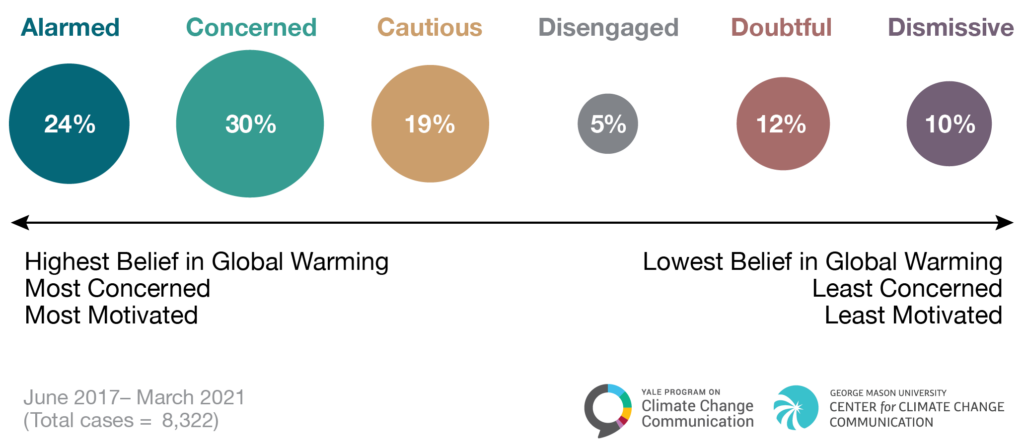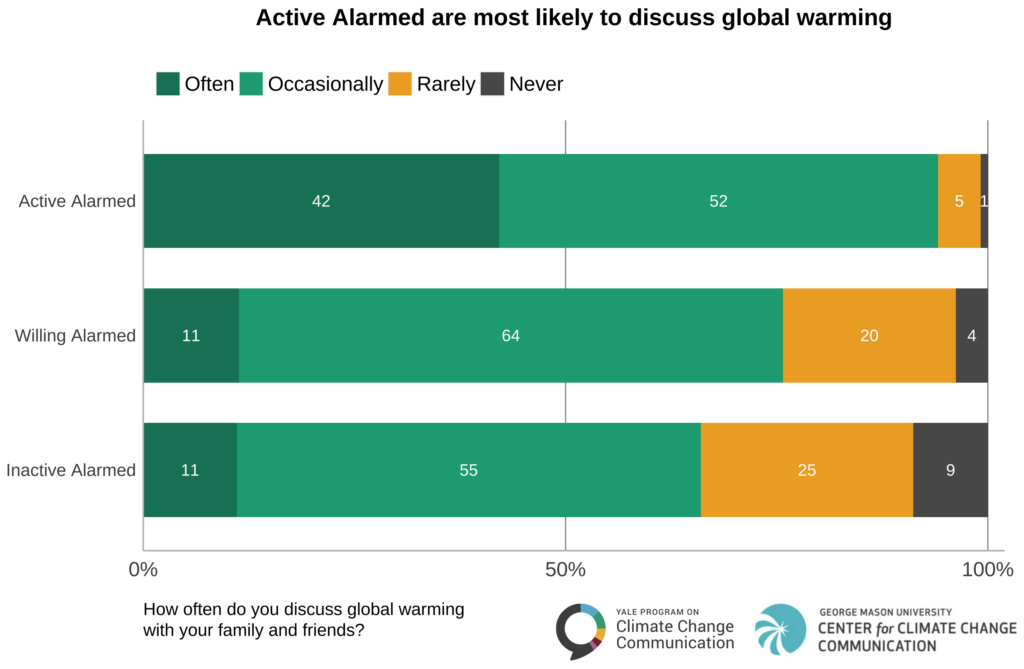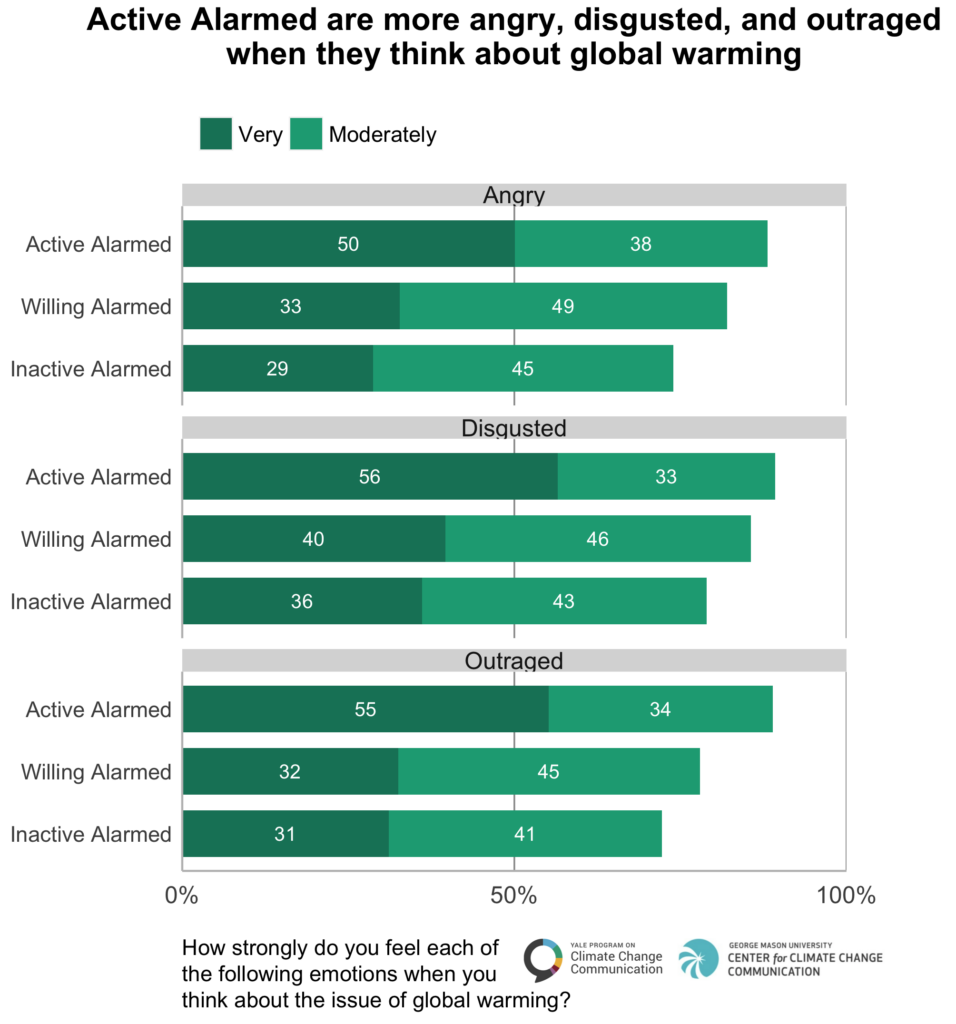Climate Note · Jul 27, 2021
Segmenting the climate change Alarmed: Active, Willing, and Inactive
By Matthew Goldberg, Xinran Wang, Jennifer Marlon, Jennifer Carman, Karine Lacroix, John Kotcher, Seth Rosenthal, Edward Maibach and Anthony Leiserowitz
Filed under: Audiences and Behaviors & Actions

To build public, consumer, and political will for climate action, it is essential to understand how different audiences respond to the issue. As part of this effort, our research has categorized Americans into six distinct groups – Global Warming’s Six Americas (figure below shows the Six Americas segments combining data from 2017-2021).
The most engaged group – the Alarmed – are very worried about climate change and strongly support actions to address it. Over the past five years, the proportion of Alarmed Americans has more than doubled. The expansion of this audience raises the question of whether there are now distinct subgroups within the Alarmed, for example, perhaps some who are more or less active.
To answer this question, we conducted a segmentation analysis of survey respondents who were previously classified as Alarmed (N = 2,019) using nine measures of their climate-related behavior including past political behavior, willingness to engage in climate activism, consumer behaviors, and social behaviors (see Method).
We identified three distinct groups within the Alarmed: the Active (34% of all Alarmed), Willing (46%), and Inactive (20%). The Active Alarmed (8% of the U.S. population) exhibit high levels of climate activism. The Willing Alarmed (11%) are willing to engage in climate activism, but currently do so relatively rarely. The Inactive Alarmed (5%) are uncertain whether they would engage in climate activism or not. More specifically, the Active Alarmed are the most likely to already be participating in a campaign to convince elected officials to take action on global warming (but only 17%). Almost none of the Willing Alarmed are currently participating in such a campaign, but a large majority say they “definitely” (13%) or “probably” would (55%). In contrast, almost none of the Inactive Alarmed are currently participating in such a campaign and many say they are not sure if they would participate.
More specifically, the Active Alarmed are the most likely to already be participating in a campaign to convince elected officials to take action on global warming (but only 17%). Almost none of the Willing Alarmed are currently participating in such a campaign, but a large majority say they “definitely” (13%) or “probably” would (55%). In contrast, almost none of the Inactive Alarmed are currently participating in such a campaign and many say they are not sure if they would participate. Members of the three Alarmed segments also differ in their willingness to advocate for climate action. Majorities of the Active and Willing say that they definitely or probably would contact government officials, meet with elected officials, donate to pro-climate organizations, and volunteer for organizations working to reduce global warming. However, the Active are much more likely to say they “definitely” would, whereas the Willing are more likely to say they “probably” would. The Inactive are again most likely to say they don’t know if they would engage in these behaviors.
Members of the three Alarmed segments also differ in their willingness to advocate for climate action. Majorities of the Active and Willing say that they definitely or probably would contact government officials, meet with elected officials, donate to pro-climate organizations, and volunteer for organizations working to reduce global warming. However, the Active are much more likely to say they “definitely” would, whereas the Willing are more likely to say they “probably” would. The Inactive are again most likely to say they don’t know if they would engage in these behaviors. Nearly all of the Active Alarmed (94%) discuss global warming with friends and family at least occasionally. By contrast, sizable proportions of the Willing Alarmed (24%) and Inactive Alarmed (34%) say they discuss global warming with their friends and family “rarely” or “never.”
Nearly all of the Active Alarmed (94%) discuss global warming with friends and family at least occasionally. By contrast, sizable proportions of the Willing Alarmed (24%) and Inactive Alarmed (34%) say they discuss global warming with their friends and family “rarely” or “never.”
The three segments are similar with regard to age, race/ethnicity, and geographic region. However, compared to the other segments, the Inactive are more likely to be female, and to have a household income of less than $25,000. Further, the Inactive are much more likely than the other segments to say they do not affiliate with a political party.
The Active Alarmed are much more likely than the other Alarmed subgroups to express a sense of collective political efficacy regarding climate action, saying they are “very” or “extremely” confident that they, working together with like-minded others, can affect what their federal, state, and local governments do about global warming. In contrast, the Inactive are the most likely to say that they are “not at all confident” they could affect what governments do about global warming. There are also large differences in emotional responses to climate change among the Alarmed segments. The Active Alarmed are much more likely than the other two segments to say they feel “very” angry, disgusted, or outraged when they think about global warming.
There are also large differences in emotional responses to climate change among the Alarmed segments. The Active Alarmed are much more likely than the other two segments to say they feel “very” angry, disgusted, or outraged when they think about global warming.  Overall, these findings have important practical implications for climate change communication. Although Americans are increasingly convinced that climate change is a serious problem that requires large-scale action, relatively few are demanding that leaders act. Campaigns tailored to engage members of the three different Alarmed subgroups can help promote climate activism and other pro-climate behaviors.
Overall, these findings have important practical implications for climate change communication. Although Americans are increasingly convinced that climate change is a serious problem that requires large-scale action, relatively few are demanding that leaders act. Campaigns tailored to engage members of the three different Alarmed subgroups can help promote climate activism and other pro-climate behaviors.
The Active Alarmed are the most engaged of the three segments and there is ample opportunity to convert their strong willingness into action: 17% are participating in a campaign now, but an additional 77% say they are willing to. Recruiting, training, and mobilizing this segment to advocate for societal action is a critical next step.
Most members of the Willing Alarmed say they would probably take action on climate, if asked, although with a lower level of commitment than the Active Alarmed. Nevertheless, these results point to the importance of outreach to all who are Alarmed about climate change. For instance, explaining how advocacy makes a difference can help promote a sense of political efficacy.
It is also important to note, however, that the reasons for action or inaction are not only driven by psychological factors such as beliefs, efficacy, or emotions. People face a variety of personal and structural barriers that can make it difficult to participate in climate action. Thus, climate advocacy organizations should work to reduce barriers where possible, while also working to motivate action.
Method
These data are from the Climate Change in the American Mind survey, a nationally-representative survey of public opinion on climate change in the United States conducted by the Yale Program on Climate Change Communication and the George Mason University Center for Climate Change Communication. Surveys were conducted from June 2017 to March 2021 (N = 2,019) using the Ipsos KnowledgePanel®, a representative online panel of U.S. adults (18+). All questionnaires were self-administered by respondents online.
Nine behavioral measures were used for the segmentation. One measure focused on past political behavior: how often respondents reported contacting government officials to urge them to take action on global warming. To measure willingness to engage in climate activism, we used four questions that asked respondents how willing they would be to contact government officials, meet with elected officials, donate to a pro-climate organization, or volunteer for an organization working to mitigate global warming. Further, we measured people’s willingness to join a campaign to convince elected officials to take action on global warming. We also asked respondents how often they reward or punish companies based on the companies’ actions related to global warming as measures of consumer behavior. And finally, we measured one social behavior: how often respondents discuss global warming with their friends and family.
We used latent class analysis to conduct the segmentation. We used the poLCA package in R to conduct the analysis.